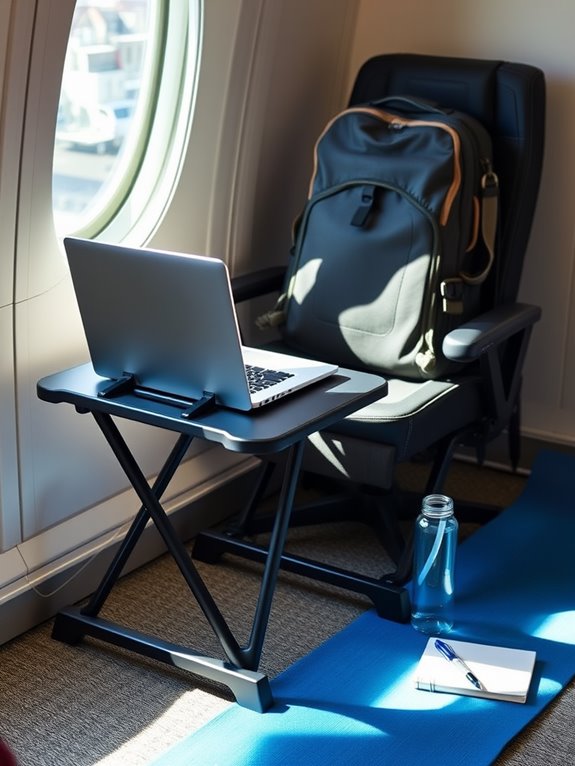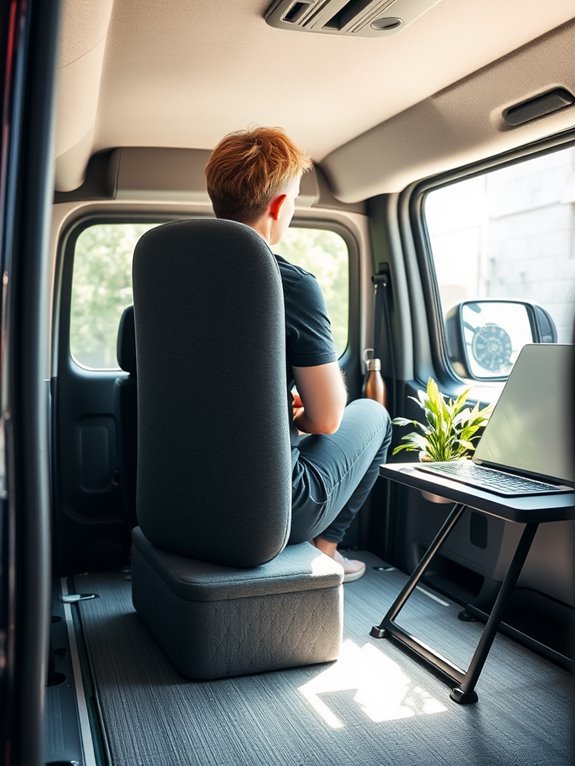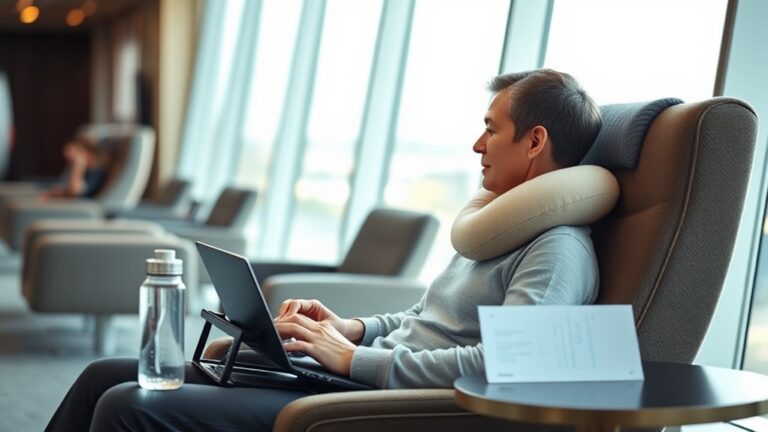To improve your posture while working on the road, invest in ergonomic travel gear like a supportive laptop bag and portable stand. Set up your workspace to avoid strain by placing your screen at eye level and using a wireless keyboard. Stay mindful of your sitting posture by keeping your back straight and engaging your core. Remember to take stretch breaks, wear comfortable shoes, and maintain a healthy sleep routine for overall well-being. Discover more tips to enhance your comfort and productivity.
Nomad Highlights
- Use a portable laptop stand to elevate your screen to eye level and reduce neck strain while working.
- Invest in a lumbar support cushion to maintain proper spine alignment during long hours of sitting.
- Take regular stretch breaks every hour to release tension and improve flexibility in your muscles.
- Stay hydrated and consume balanced snacks to maintain energy levels and reduce fatigue while working on the road.
- Practice mindful sitting by engaging your core and keeping your back straight to support good posture.
Choose the Right Travel Gear

Choosing the right travel gear can make a significant difference in how you feel while working on the road. First, invest in a high-quality laptop bag that offers support and comfort. Look for one with padded straps and compartments to keep your tech organized.
Investing in a quality laptop bag with support and organization is essential for a comfortable and productive journey.
Consider a portable stand to elevate your laptop for better eye level, which can help reduce neck strain. A lightweight, foldable chair can provide extra support when you need a break. Don’t forget to pack noise-canceling headphones to minimize distractions and create a focused environment. Additionally, using resistance bands during breaks can help improve muscle strength while you travel. Finally, choose comfortable, breathable clothing to keep you relaxed throughout your travels. Additionally, selecting a stand with adjustable height options can further enhance your posture improvement while working on the go. Stands with good ventilation designs can help prevent your device from overheating during extended use. Furthermore, using a durable footrest can promote circulation and improve your overall comfort while sitting for long periods. Furthermore, selecting a stand with stability and durability ensures that your device remains secure and prevents tipping during use.
With the right gear, you’re setting yourself up for a more productive and enjoyable work experience on the go.
Set Up an Ergonomic Workspace

While you might find it challenging to create a comfortable workspace on the road, setting up an ergonomic environment is essential for your health and productivity.
Start by choosing a flat surface at the right height to avoid strain. If possible, use a portable laptop stand to keep your screen at eye level. Adjust your chair or cushion to support your lower back, ensuring your feet rest flat on the ground. Additionally, prioritize breathable materials in any portable seating options you choose to enhance comfort during extended use. An ergonomic setup also includes using DPI settings to ensure your mouse sensitivity is comfortable for your work tasks. Consider incorporating ergonomic monitor mounts to improve screen positioning and further reduce strain. Using a lumbar support cushion can also help promote proper spinal alignment during long working hours.
Use a wireless keyboard and mouse for better wrist alignment. Make sure there’s adequate lighting to reduce eye strain.
Finally, keep essential items within arm’s reach to avoid unnecessary stretching. By taking these steps, you can create a workspace that supports your posture and helps you work efficiently wherever you are. Additionally, consider using portable standing desk converters to enhance your workspace ergonomics and comfort.
Practice Mindful Sitting

To maintain good posture, you need to practice mindful sitting throughout your workday. Focus on your alignment as you sit. Keep your back straight and shoulders relaxed, with your feet flat on the ground or on a footrest. Incorporating ergonomic products can significantly enhance your sitting experience and support better alignment.
Avoid slouching or leaning forward, which can strain your spine. When working, engage your core muscles to support your back. It can help to set reminders on your phone to check your posture every hour. Take a moment to adjust your seat and confirm your monitor is at eye level, so you’re not looking down. By being aware of your posture and making small adjustments, you’ll not only feel better, but you’ll also be more productive during your work sessions. Incorporating exercises with ankle resistance bands can also help strengthen your core and improve overall stability.
Incorporate Stretch Breaks

Incorporating stretch breaks into your work routine can greatly enhance your posture and overall well-being. When you’re on the road, it’s easy to fall into a sedentary pattern, leading to stiffness and discomfort.
Set a timer to remind yourself to take a break every hour. Stand up, reach for the sky, and gently twist your torso to release tension. Simple stretches like neck rolls and shoulder shrugs can work wonders. Additionally, using a compact air purifier can help improve indoor air quality, ensuring you breathe clean air while you work. Remember, regular breaks to stretch are essential for maintaining proper posture and can also contribute to reducing tension in your body.
If possible, step outside for fresh air while you stretch; it can re-energize you. Remember, these short breaks not only improve your posture but also boost productivity and focus. Consider using a compact air purifier during your breaks to maintain clean air quality in your workspace.
Utilize Supportive Accessories

Supportive accessories can make a significant difference in maintaining good posture while working on the road.
Consider investing in a portable lumbar support cushion. This cushion helps maintain the natural curve of your spine, reducing strain during long hours in your car or at a makeshift desk. Many ergonomic chairs feature adjustable lumbar support, which can be particularly beneficial for customized comfort. Additionally, using a compact foam roller during breaks can help relieve muscle tension and improve circulation. Incorporating portable essential oil diffusers can also enhance your overall well-being and promote relaxation during work. Regular use of supportive accessories can lead to increased mobility and improved overall wellness.
Investing in a portable lumbar support cushion can help preserve your spine’s natural curve and reduce strain during long hours of work.
A lap desk or portable laptop stand can elevate your device, preventing awkward angles that lead to discomfort.
Don’t forget about ergonomic headphones or a headset. They free your hands while keeping your neck aligned.
Finally, wear comfortable shoes with good arch support to keep your entire body aligned. Additionally, using memory foam travel pillows can greatly enhance neck support during travel, reducing discomfort and promoting better posture.
Stay Hydrated and Nourished

While using supportive accessories can boost your comfort, staying hydrated and nourished plays an essential role in maintaining good posture and overall well-being on the road.
When you’re properly hydrated, your muscles function better, reducing fatigue and tension. Aim to drink water regularly, even if you don’t feel thirsty. Keep a reusable water bottle handy to remind yourself, especially one with a filter for contaminants to ensure clean hydration. Additionally, consider using portable protein powder to enhance your nutrition while traveling. It’s also beneficial to include hand sanitizers with 62% ethyl alcohol to help maintain germ-free hands during your journey.
Nourishment is just as vital. Opt for balanced snacks like nuts, fruits, or yogurt, which provide sustained energy without a sugar crash. Consider incorporating snacks with whole food ingredients that help maintain energy levels without added sugars. Avoid heavy meals that can make you sluggish.
Eating smaller portions throughout the day keeps your energy levels stable and supports better posture. Remember, your body needs fuel to stay upright and engaged, so prioritize hydration and nutrition on your travels. Incorporating protein bars into your snack rotation can provide a convenient and nutritious option to help maintain energy levels on-the-go.
Be Aware of Your Screen Height

Here are three tips to help you set up your workspace:
- Eye Level: Confirm your screen is at eye level. This way, you won’t have to tilt your head up or down, promoting a more neutral spine alignment. Additionally, maintaining proper ergonomic designs can significantly enhance your overall comfort during prolonged working hours.
- Distance: Keep your screen about an arm’s length away. This distance helps reduce eye strain while allowing you to maintain a relaxed posture.
- Adjustable Stands: Use an adjustable stand or laptop riser. This flexibility allows you to change the height based on your seating arrangement, guaranteeing ideal posture wherever you are. Additionally, using ergonomic handles in your workspace setup can enhance comfort and support during long hours of work.
Engage Your Core Muscles

Engaging your core muscles is essential for maintaining good posture while working on the road.
Incorporating core strengthening exercises, daily stretching routines, and mindful breathing techniques can make a significant difference. You’ll find that a strong core not only supports your posture but also boosts your overall comfort and productivity. Additionally, using a stretching strap can enhance your flexibility and aid in recovery, further contributing to your posture improvement efforts. Using tools like exercise sliders can also help you effectively engage your core during workouts and improve your overall stability. Moreover, employing resistance bands can provide versatile resistance training options that enhance core engagement, making workouts more effective. Incorporating a variety of resistance levels from 5 lbs to 150 lbs can significantly target different muscle groups while improving core strength. Additionally, utilizing adjustable dumbbells can offer a convenient way to incorporate weight training into your routine, further enhancing your core stability and overall fitness.
Core Strengthening Exercises
A strong core is essential for maintaining good posture, especially when you’re working on the road. Engaging in core strengthening exercises can greatly enhance your stability and support your spine. Additionally, using a fitness tracker can help you monitor your daily activity levels and remind you to take breaks for these exercises. Many devices offer 24/7 health monitoring features to keep track of your well-being throughout your travels.
Here are three effective exercises you can do anywhere:
- Planks: Hold your body in a straight line from head to heels, supporting yourself on your forearms and toes. Start with 20-30 seconds and gradually increase the duration.
- Russian Twists: Sit on the ground with your knees bent and lean back slightly. Twist your torso to touch the ground beside you, alternating sides for 10-15 reps.
- Bird-Dogs: Start on all fours and extend one arm and the opposite leg. Hold for a few seconds, then switch sides. This improves balance and core stability.
Incorporate these exercises into your routine to boost your core strength! Additionally, maintaining good posture can be supported by tracking your daily activities and workouts with a fitness tracker.
Daily Stretching Routines
While you’re on the road, incorporating daily stretching routines can greatly enhance your core engagement and overall posture. Engaging your core muscles not only supports your spine but also helps you maintain balance. Here’s a simple stretching routine you can follow:
| Stretch | Duration | Benefits |
|---|---|---|
| Cat-Cow Stretch | 1 min | Increases spinal flexibility |
| Seated Forward Bend | 1 min | Stretches the back and hamstrings |
| Side Stretch | 1 min | Opens up the sides and improves flexibility |
| Standing Quad Stretch | 1 min | Strengthens the hip flexors and quads |
Try to include these stretches in your daily routine. You’ll notice improved core strength and better posture, making your time on the road more comfortable.
Mindful Breathing Techniques
How can mindful breathing techniques enhance your core engagement and overall posture? By focusing on your breath, you can activate your core muscles, which provides stability and support for your spine.
This heightened awareness not only improves posture but also helps reduce tension, promoting a more relaxed state while working.
Here are three mindful breathing techniques to try:
- Diaphragmatic Breathing: Inhale deeply through your nose, allowing your diaphragm to expand. Exhale slowly through your mouth, engaging your core muscles as you do.
- Box Breathing: Inhale for four counts, hold for four, exhale for four, and hold again for four. This rhythm encourages focus and muscle engagement.
- Mindful Exhalation: As you exhale, consciously tighten your core, reinforcing good posture and stability.
Use Comfortable Footwear

When you’re on the road, the right footwear can make a huge difference in your posture and comfort.
Choose supportive shoes that fit well and provide adequate arch support to keep your feet and back aligned.
Prioritizing comfort will help you stay focused and productive, no matter where you are.
Choose Supportive Shoes
Choosing supportive shoes is essential for maintaining comfort and proper posture while working on the road.
When you’re on your feet for long periods, the right footwear can make all the difference. Here are three key features to look for:
- Arch Support: Shoes with proper arch support help distribute your weight evenly, reducing strain on your feet and lower back.
- Cushioning: Opt for shoes with ample cushioning to absorb shock and minimize impact on your joints with every step you take.
- Stability: Choose shoes that provide good stability, especially if you’re walking on uneven surfaces, to prevent any risk of injuries.
Investing in supportive shoes won’t only enhance your comfort but also improve your overall posture while you work.
Consider Shoe Fit
A proper shoe fit is essential for comfort and posture, especially when you’re on the road. Ill-fitting shoes can lead to discomfort, affecting your focus and productivity.
When selecting footwear, make sure there’s enough room in the toe box; your toes shouldn’t feel cramped. Pay attention to the width as well; shoes that are too tight can cause blisters and pain.
It’s also important to contemplate the heel height; avoid styles that force your feet into unnatural positions. Trying shoes on later in the day can help, as your feet swell slightly throughout the day.
Finally, don’t overlook the materials—breathable fabrics can keep your feet cool and comfortable during long hours of travel. Choose wisely to support your posture effectively!
Prioritize Arch Support
Finding the right shoe fit is just the start; prioritizing arch support is equally important for maintaining comfort and posture while working on the road.
The right arch support can prevent fatigue and keep you focused. Here are three factors to evaluate when choosing supportive footwear:
- Cushioning: Look for shoes that provide ample cushioning to absorb impact during long hours of standing or walking.
- Insoles: Think about using orthotic insoles that contour to your foot’s arch, offering personalized support.
- Material: Select breathable materials that allow your feet to stay cool and dry, reducing discomfort and enhancing overall foot health.
With the right arch support, you’ll feel more comfortable and maintain better posture throughout your travels.
Maintain a Healthy Sleep Routine

Although it can be challenging to maintain a consistent sleep routine while traveling, prioritizing rest is essential for both your well-being and posture. Aim to go to bed and wake up around the same time, even in different time zones.
Create a relaxing bedtime routine—consider reading or meditating to signal your body it’s time to wind down. Make your sleeping environment comfortable; use earplugs or an eye mask to block out noise and light.
Avoid screens before bed, as blue light can disrupt your sleep cycle. If you’re staying in a hotel, request a room away from elevators and high-traffic areas.
Frequently Asked Questions
How Does Poor Posture Affect Productivity While Working on the Road?
Poor posture can lead to discomfort and fatigue, making it harder for you to focus and stay productive. When you’re on the road, this can hinder your ability to perform tasks efficiently and effectively.
Can Posture Impact My Long-Term Health While Traveling?
You might think posture’s just a minor concern, but it considerably impacts your long-term health. Poor alignment can lead to chronic pain, fatigue, and even serious conditions, so maintaining good posture while traveling is essential for wellness.
What Are the Signs of Poor Posture to Watch For?
You can spot poor posture by noticing back pain, shoulder tension, or neck stiffness. If you find yourself slouching, tilting your head forward, or experiencing fatigue, it’s time to adjust your sitting habits.
How Often Should I Reassess My Travel Gear for Posture Support?
You should reassess your travel gear for posture support every few months or whenever you notice discomfort. Regular checks help guarantee your equipment meets your needs, keeping you comfortable and reducing the risk of strain.
Are There Specific Exercises to Improve Posture While Sitting in a Car?
While you’re stuck in your mobile office, try subtle stretches like neck rolls and seated twists. Just a few minutes can keep your spine happy and help you avoid that all-too-familiar slump behind the wheel.
Conclusion
Improving your posture while working on the road isn’t just a nice idea—it’s a game changer! By choosing the right gear, setting up an ergonomic workspace, and taking regular stretch breaks, you can transform your travel experience. Remember to engage your core and stay mindful of your screen height. With a few simple adjustments, you’ll feel like a posture superhero, ready to tackle any task that comes your way, no matter where you are!




